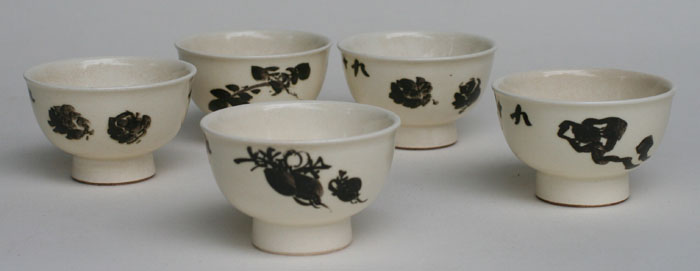Nanga
Set of 5 tea cups, Pine cones (2x), reishi, hishi, and shells and seaweedSigned: Kujû ô Chokunyû dôjin sha
Seals: Seifu
Technique: Cream glazed kyôyaki with dark brown underglazed decorations Ø 7,7 x 4,8
Date: 1903
Box: signed by Seifu
Chokunyû was born in Ôita Takeda in Bungo province. His master Tanomura Chikuden (1777-1835) came from the same area. Chokunyû became his pupil when he was in his 9th year. Chikuden recognized his talents and adopted him, upon which Chokunyû gave up his own family name of Mitsumiya. Apart from his painting activities he also immersed himself in Chinese studies. He was, moreover, a pivotal figure in sencha-loving circles in Kyoto and Osaka. As the number of devotees augmented, he founded a sencha society in Osaka in order to preserve and consolidate the work of earlier sencha enthusiasts like Rai San’yô (1781-1832). It became known as the Seiwan Chakai, Blue Bay Tea Society. As its originator and promoter Chokunyû achieved tremendous fame. Early in the Meiji era he became involved in the founding of Kyoto’s Prefectural Art School and in due course became its first director. He also helped to establish the Japanese Nanga Society. He was a prolific artist not only drawn to landscape and flowers, trees and grasses, but also to birds, animals and human figures. With Tomioka Tessai (1836-1924) he was a leading figure in the sencha world of the Meiji era.
Reference:
Roberts p. 174
Araki pp. 1080-1081
Graham p. 171 ff.
Berry & Morioka ‘99 p. 92-95 (# 12)
Berry & Morioka ‘08 p. 303-05 (# 42-43, 79)
Seifu III. was the son of the Maruyama-school painter Okada Ryohei. He studied painting at the age of thirteen with Tanomura Chokunyû and pottery with Seifu Yohei II. He took over the Seifu workshop in 1872 and adopted the name Seifu III in 1878 after the death of his teacher. Building on family tradition he attempted to achieve complete mastery in the combination of ceramics and painting. He made great efforts to improve the quality of Kyoto wares. Unlike many potters of the time, Seifu was low inproduction and tenacious in approach. He was a founding member of the potters’ associations of Awata and Kiyomizu Gojôzaka and of the Kyoto Ceramic Research Institute. Working in a Sino-Japanese style, he produced mainly for the domestic market and received many awards in Japan. In 1893 Seifu became the first ceramist to be admitted to the Teishitsu Gigei-in and in 1895 he was made a member of the Order of the Green Ribbon.
Reference:
Roberts p. 139
Jenyns 1965 p. 303
Jahn p. 99 ff.
Price: SOLD

